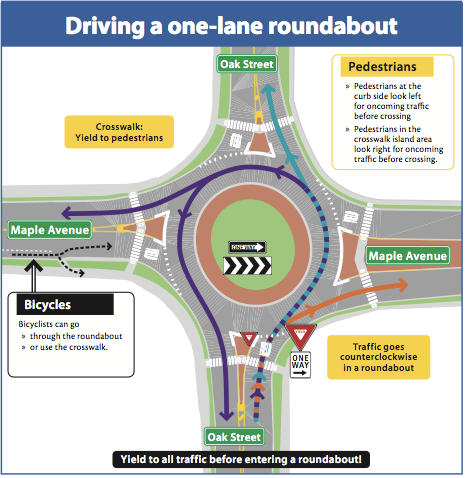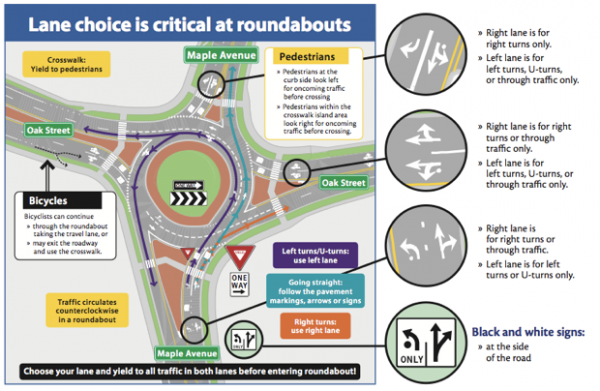Session 12 – Roundabout Rules
RULES FOR DRIVING ROUNDABOUTS
General information for all roundabouts
Roundabouts are becoming more common in the U.S. because they provide safer and more efficient traffic flow than standard intersections. By keeping traffic moving one-way in a counterclockwise direction, there are fewer conflict points and traffic flows smoothly.
Crash statistics show that roundabouts reduce fatal crashes about 90%, reduce injury crashes about 75%, and reduce overall crashes about 35%, when compared to other types of intersection control.
When driving a roundabout, the same general rules apply as for maneuvering through any other type of intersection.
Truck apron
Large vehicles need more space when driving in a roundabout. A truck apron is a paved area on the inside of the roundabout for the rear wheels of large trucks to use when turning, sometimes referred to as off-tracking. Truck aprons are not to be used by cars, SUVs, or pickup trucks.
Steps for driving a roundabout:
- Slow down. Obey traffic signs.
- Yield to pedestrians and bicyclists.
- Yield to traffic on your left already in the roundabout.
- Enter the roundabout when
there is a safe gap in traffic. - Keep your speed low
within the roundabout. - As you approach your exit, turn on your right turn signal.
- Yield to pedestrians and bicycles as you exit.
Emergency vehicles in the roundabout
- Always yield to emergency vehicles.
- If you have not entered the roundabout, pull over and allow emergency vehicles to pass.
- If you have entered the roundabout, continue to your exit, then pull over and allow emergency vehicles to pass.
- Avoid stopping in the roundabout.
Driving a roundabout with two or more lanes
Choose the proper lane before entering: As you get closer to the roundabout entrance, it is very important to observe the signs and arrows to determine which lane to use before entering a roundabout. Black and white signs on the side of the road and white arrows on the road will show the correct lane to use. In general, if you want to make a left turn, you should be in the left lane or other lanes that are signed and marked as left turn lanes. If you want to make a right turn, you should be in the right lane or other lanes that are signed and marked as right turn lanes. If you want to go straight, observe the signs and arrows to see what lane is correct.

Left turns/U-turns: use left lane
- When approaching the roundabout, use the left lane, or other lanes that are signed and marked as a left turn lane.
- Yield to pedestrians in the crosswalk.
- Yield to all traffic on your left before entering the roundabout.
- Enter the roundabout when there is a safe gap in traffic.
- Use your right turn signal to exit the roundabout.
- Yield to pedestrians in the crosswalk at the exit.
Going straight: use right lane or left lane
- When approaching the roundabout, choose the correct lane for your desired exit.
- Yield to pedestrians in the crosswalk.
- Yield to all traffic on your left before entering the roundabout.
- Enter the roundabout when there is a safe gap in traffic.
- Stay in your lane.
- Use your right turn signal to exit the roundabout.
- Yield to pedestrians in the crosswalk at the exit.
Right turns: use right lane
- When approaching the roundabout, use the right lane, or other lanes that are signed and marked as a right turn lane.
- Yield to pedestrians in the crosswalk.
- Yield to all traffic on your left before entering the roundabout.
- Enter the roundabout when there is a safe gap in traffic.
- Stay in your lane.
- Use your right turn signal to exit the roundabout.
- Yield to pedestrians in the crosswalk at the exit.
Large vehicles
- Large vehicles need more space in a roundabout.
- All drivers should be cautious and avoid driving next to or passing large trucks while approaching and maneuvering through a roundabout.
- A truck apron is a paved area inside a roundabout.
- It is for the rear wheels of large trucks to use when turning.
- Trucks may cross into other lanes or onto the truck apron.
- Truck aprons are not to be used by cars, SUVs, or pickup trucks.

